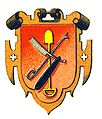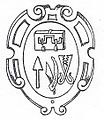barber
Barbier (like Italian barbiere and French barber from late Latin Barbarius "Bartscherer", from the Latin barba "beard"), Frühneuhochdeutsch also barbers , is a skilled trade . A barber is a hairdresser with male customers. He cuts and styles or shaves men's scalp hair as well as their beards .
In the Middle Ages and the beginning of the modern era , barbers worked in bathhouses in Europe and in countries of the Orient . In the European bathing rooms, they took on various personal care tasks . Bathers, surgeons and nurses were also referred to as barbers or jugglers . They were also responsible for tooth extractions , bloodletting and enemas .
In modern times, the job profile changed to the barber shop , who offered haircuts and hairstyles as well as shaving or grooming the beard. In the 20th century, the barber's profession almost died out in Europe. However, this branch of the hairdressing trade has been experiencing a renaissance since around 2010. In the modern barber scene, English terms are often used in German-speaking countries as well: barber for the barber and barbershop for the salon.
history
middle Ages
In Europe the barber was already known in the 8th century (as a razor responsible for shaving or as a sanguinator practicing bloodletting ). In a regulation written in 1284 or 1285, which regulated the craft of the guild-like barbers in Venice, it was stated that the area of responsibility also included bloodletting and tooth extraction, but also other dental treatment. A 13th-century relief on the main portal of San Marco in Venice shows the shaving and dental treatment carried out by barbers. The barbers probably evolved from the servants and specialized in certain tasks of the bathers. An early mention of the barbers can be found in an official letter in Cologne in 1397. Barber guilds can be found in the Hanseatic cities from the second half of the 15th century: 1457 in Danzig, 1480 ( barber roll ) in Lübeck, 1486 in Hamburg.
Barbers were also called dry shearers because, unlike the bathers, they did not offer a hot bath. Since both men and women were completely unclothed in a hot bath, illnesses could be transmitted very easily, which is why bathers were less respected in the eyes of barbers. First of all, barbers provided haircuts and “dry” shaving. In addition, the barbers, some of whom have read specialist literature, also treated wounds, broken bones, pulled teeth, performed bloodletting or made ointments.
From the Middle Ages to the early modern period , the barber's profession was considered " dishonorable " and thus a dishonest profession . In the urban class societies of the Middle Ages, children from barber families were therefore mostly excluded from being accepted into other guilds . It was not until the middle of the 16th century that the imperial laws of 1548 and 1577 gave them the opportunity to learn another craft.
In the Orient barbers worked (Arabic Muzayyin , plural muzayyūn ) in the Middle Ages in the public bathhouse ( hammam ). Men could have their hair cut and their beards shaved here. In some hammams, especially in the larger baths, barbers were employed specifically for this purpose, otherwise another employee, such as a bath maid, took over the task. Often the customer was not only shaved off the beard, but also the entire hair on the head . Women either went to a women's bathhouse or they took turns using the bathhouse with the men, but their hair was not cut there. Barbers only became self-employed in modern times. Since then they have been working in their own salons and are no longer to be found in the bathhouses.
19th century
With the development and professionalization of doctors in the early 19th century, the barbers sought to further specialize. With the wigs , the branch of the wigmaker emerged, which began with Louis XIII. his high season got because he went bald early, but did not want to do without a full head of hair.
In 1889 the Association of Barber, Hairdressing and Wig Maker's Aid in Germany was founded. At its third congress in Cologne (1892), the association then had 19 branches with 636 members, it renamed itself the Association of German Barbers, Hairdressers and Wig Makers . At the fourth congress in Berlin (1894) a commission was elected to draft a comprehensive memorandum on the poor working conditions for the legislature. In it, the working hours in northern Germany were given as “an average of 100 to 105 hours per week”. The memorandum was submitted to the Federal Council and the Reichstag on March 5, 1895 . Sunday rest in the hairdressing trade - a main requirement of the association - was regulated by law on April 1, 1895. The association brought out its own magazine, initially with the title Der Kundschafter , from 1895 with the new name Barbier- und Friseur-Zeitung (later Friseurgehilfen-Zeitung ). In 1896 500 members were organized in 24 branch clubs.
20th century
With the invention of the safety razor towards the end of the 19th century, many men switched to shaving themselves, which has made shaving at the barber's or barber's shop the exception. In the 1960s, mixed hairdressing salons with women and men as customers emerged. This business model finally caught on. In terms of hairdressing training, specialized training for barbers was no longer offered, although these work differently from ladies' hairdressers. A Dutch barber explains: "For example, a barber works a lot more with the clippers and only washes the hair after it has been cut."
Barbers and bathers existed in Germany until around 1930 as state-certified bathers.
21st century
In the 2010s, the barber's profession was revived in Germany when more and more so-called barber shops were founded, which focus on male customers and demanding beard care in addition to haircut. As one of the first pioneers, a master hairdresser from Wolfsburg founded a men's salon called Mr. Schneider in Hamburg-Rotherbaum in 2010 . At the time, colleagues thought he was crazy because it was taken for granted that only customers generate sales and that there is no demand for beard care. The number of barber shops in Germany grew from around 250 in 2015 to around 400 to 500 within a year. In 2019 a barber reported: “Suddenly a barber shop opens on every corner. It's just exploding. "
The newly founded barber industry has been organizing competitions in Germany since 2015, initially the German Barber Award 2015 with eight participants in the final. At the German Barber Award 2016, there was one woman among the 15 competitors in the final. 2017, the competition was international: As part of the hairdressing trade fair hair to barbers from all over Europe for could International Barber Award and the award for Best Senior Barber apply. At the International Barber Awards 2018, 60 out of hundreds of applicants entered the preliminary round competitions, which were held in various European cities. In the final in Nuremberg with 19 participants, two barbers from Sofia (Bulgaria) and Oslo (Norway) won and came second.
Testimonies
See also
literature
- Gundolf Keil , Hans-Peter Baum : Barber. In: Lexicon of the Middle Ages . Volume 1 (1980), Col. 1444 f.
- Reinhold Reith : Lexicon of old handicrafts: bathers and barbers. From the late Middle Ages to the 20th century, 2nd edition, Beck, Munich 1991, ISBN 3-406-34470-4 .
- Gertrud Wagner: The trade of baths and barbers in the German Middle Ages. (Phil. Dissertation Freiburg im Breisgau 1918) Zell i. W. (Buchdruckerei F. Bauer) 1917.
- Gustav Adolf Wehrli: The bathers, barbers and surgeons in old Zurich. Zurich 1927 (= communications from the Antiquarian Society in Zurich , XXX, 3).
- Gerhard Wulz, Thomas Ahnert [Red.], Peter Weidisch [Red.]: Connected to beauty: history and stories about hair, about beauty and body care, about bathers, barbers and hairdressers . Imhof, Petersberg 2003. ISBN 3-935590-88-1 ( special publications of the Bad Kissingen City Archives, Vol. 4: Exhibition of the City of Bad Kissingen, Bad Kissingen, Old Town Hall, April 11 to July 20, 2003).
Web links
Individual evidence
- ^ Friedrich Kluge , Alfred Götze : Etymological dictionary of the German language . 20th edition, ed. by Walther Mitzka . De Gruyter, Berlin / New York 1967; Reprint (“21st unchanged edition”) ibid 1975, ISBN 3-11-005709-3 , p. 51.
- ↑ Cf. for example Early New High German Dictionary: Barbierer, Barbier .
- ↑ a b Cf. Barbier at Duden online, meanings: "Herrenfriseur" and "Wundarzt".
- ^ Bernhard Dietrich Haage: Medical Literature of the Teutonic Order in the Middle Ages. In: Würzburg medical history reports. Volume 9, 1991, pp. 217-231; here: p. 222.
- ↑ Ruth Spranger: The barbers in the Mestieri archivolte of San Marco in Venice. Reflections on the barber profession and the guilds in medieval Venice. In: Würzburg medical history reports. Volume 9, 1991, pp. 233-247.
- ↑ Walter von Brunn : From the guilds of barbers and surgeons in the Hanseatic cities. Leipzig 1921.
- ↑ Stanislaw Sokól: The library of a barber from the year 1550. In: Centaurus 7, 1961, pp 197-206.
- ^ Jost Schneider: Social history of reading: on the historical development and social differentiation of literary communication in Germany . Walter de Gruyter, Berlin 2004, p. 154. ISBN 3-11-017816-8
- ↑ German Encyclopedia or General Real Dictionary of All Arts and Sciences . Volume 18, Varrentrapp and Wenner, Frankfurt am Main 1794, p. 277
- ↑ a b c Heinz Grotzfeld: The bathroom in the Arab-Islamic Middle Ages. A study of cultural history. Harrossowitz, Wiesbaden 1970, p. 73 f. ( here in the google book search)
- ^ A b Bathhouses article in the Encyclopædia Iranica on Iranian bathhouses (English). Quote in the context of shaving the head and beard for men: Women keep their hair .
- ↑ Stark, Robert (1869–1929) Biography in the digital library of the Friedrich-Ebert-Stiftung, 1998.
- ↑ Etzkorn, Friedrich (1874–1946) Biography in the digital library of the Friedrich-Ebert-Stiftung, 1998.
- ↑ Our story barbershopcoevorden.nl, section amputations .
- ↑ a b Men's cosmetics: Longing for a time "when men were still men" welt.de, April 11, 2019.
- ↑ a b Barber Awards 2016: washing, cutting, drinking whiskey spiegel.de October 17, 2016.
- ↑ International jury at the German Barber Award 2015 friseurebayern.com, November 7, 2015.
- ↑ HAARE 2017: The championships friseurebayern.com, October 4th 2017.
- ↑ HAIR 2018: International Barber Awards select the best barbers friseurebayern.com, September 6, 2018.
- ↑ The Bulgarian Tsvetelina Gergova secures the title - International Barber Awards 2018 esteticamagazine.de, October 22, 2018.




